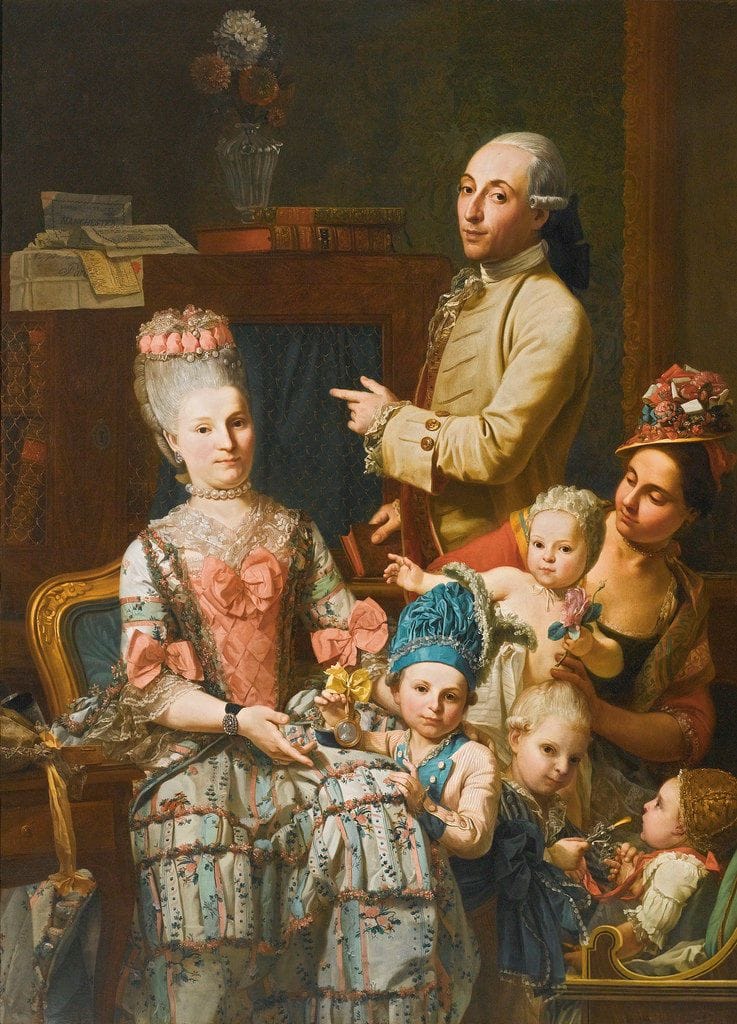

Portrait of Antonio Ghedini and His Family
Pietro Melchiorre Ferrari
...attribution for this lot should read: Pietro Melchiorre Ferrari (Sissa 1734/5 - 1787 Parma). A pupil of Giuseppe Baldrighi, to whom this picture was formerly attributed, Pietro Melchiorre Ferrari was appointed in 1785 court painter to the Bourbon Duke Ferdinand in Parma. He was a close friend of the Ghidini family and this painting is almost certainly the family portrait listed in a manuscript inventory of the pictures belonging to the heirs of Alessandro Ghidini drawn up circa 1830 ('Dipinti ed intagli vendibili degli eredi Ghidini') as: 'Un quadro grande che raprresenta I ritratti della famiglia Ghidini di Pietro Ferrari Lire nuove 110'. Additional literature: F.M. Ricci, Enciclopedia di Parma, Parma 1998 (as by Giuseppe Baldrighi); G. Cirillo, 'Dipinti inediti del Seicento e del Settecento parmense a proposito del nuovo catalogo della Galleria Nazionale', in Parma per l'Arte , VII, 2001, p. 48, reproduced fig. 19; G. Cirillo, in Le Collezioni d'Arte della Cassa di Risparmio di Parma e Piacenza, eds. G.Godi and C. Mingardi, p. 46, under cat. no. 37. We are grateful to Dott. Alberto Crispo for the above information. (http://www.sothebys.com/fr/auctions/ecatalogue/2012/old-master-british-paintings-evening-l12036/lot.45.html)
This intimate and sympathetic group portrait affords a fascinating glimpse of life and the international nature of both art and trade during the Age of Enlightenment. As the letters on the cabinet in the background attest, the sitters are Antonio Ghedini and his family from Parma, where Ghedini was an official cloth merchant to the Bourbon court. He also had strong ties to Manchester and England, then one of the most important producers of manufactured cloth in Europe. Other documents mention Manchester and an important industrial families from this period involved in cloth manufacture, the Booths. As befits the family of a leading cloth merchant, the Ghedini family are suitably modishly attired: his wife wears a brocaded silk open robe with foliate stripes, salmon-pink furbelows and matching stomacher. Her elegant dress is made from a fabric called Melandri which was produced in Lyon as well as the Veneto and in Spitalfields in London. Her fichu is in the contemporary Venetian fashion.
The attribution to Giuseppe Baldrighi was first suggested by Alastair Laing at the time of the 1998 sale (see Provenance). Baldrighi was court painter to the Bourbon Duke Philip of Parma (1720-1765), a post to which he had been appointed in 1756. Before this the portrait had been ascribed to the French court painter Louis Michel van Loo. The confusion is perhaps understandable, for Baldrighi's style was formed in Paris, where the Duke's minister Guillaume du Tillot had sent him for training. In Paris Baldrighi would been able to work alongside or at least seen the works of painters such as Boucher, De la Tour, Liotard and Nattier, and in 1754 he was received into the prestigious Académie. Baldrighi's own large conversation piece of Duke Philip and his French wife Louise-Elizabeth and their family of 1758 onwards (Galleria Nazionale, Parma) shows that by the time of his return to Parma in 1756 he had successfully assimilated the style of French painters such as Van Loo.
The present work, however, eschews the cold formalities of court portraiture for a more intimate style, best paralleled in Baldrighi's Self-portrait with two friends Callani and Ferrari of around 1760 or the slightly later Self-portrait with his wife (both now in Parma, Galleria Nazionale)1. A dating for the present portrait is provided by the medal held by the oldest boy in the centre foreground. This is the medal struck by Anton Wideman commemorating the marriage of Maria Amelia Hapsburg to Philip's successor Duke Ferdinand of Parma on the 27 June 1769, thus providing a terminus post quem for the painting itself.
By comparison with the Ducal family group painted maybe twenty years earlier, the design is markedly more sophisticated and complex, its informality presaging the work of another famous visitor to Parma in the 1770s, the german Johann Zoffany.
(http://www.sothebys.com/fr/auctions/ecatalogue/2012/old-master-british-paintings-evening-l12036/lot.45.html)
Uploaded on Aug 1, 2016 by Suzan Hamer
Pietro Melchiorre Ferrari
artworksArthur
Wait what?
